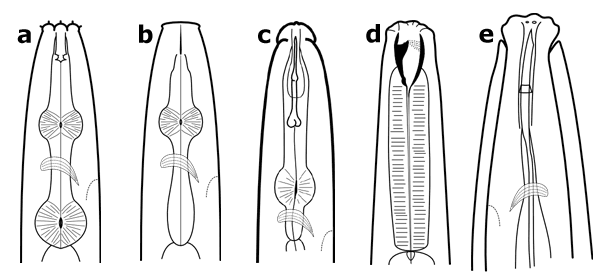Nematodes. No, these organisms have nothing to do with amphibians. Nematodes are a type of soil organisms that are grouped into the microfauna category; those organisms that are smaller than 0.1 mm in size. We are talking about microscopic little guys in the soil that you can't see without the aid of a magnifying device. Technically they are non-segmented roundworms (as opposed to segmented worms like earthworms where they can "disconnect" and both sides will continue to wiggle around). There are more than 20,000 different species of nematodes. They can survive in both "aquatic" and slightly drier parts of the soil. An example of a nematode's upper half is pictured below.

http://www.nrel.colostate.edu/projects/newsoil/research/Other%20Res.%20Pages/soge_res_nematode_bio.html
Before you go running away from this tremors-like figure, give me a second to explain what these guys do. Often people's first question about soil organisms is "Are these good or bad guys?" With nematodes as well as many soil organisms there are species that are beneficial and some that impact the system negatively. The nematode pictured above is known as
Acrobeles complexus. You are looking at its mouth piece, which is slightly frightening, resembling a torture device. However, the only beings this worm is "hurting" are bacteria. Don't feel too bad for the little guys. F
ungi and bacteria can often fight back! Parasitic nematodes (omnivores) are can be trapped by certain species of fungi. An example of this is pictured below.
http://faculty.yc.edu/ycfaculty/ags105/week10/soil_organisms/soil_organisms_print.html
Nematodes are grouped by their trophic group or basically what they choose to eat: fungi, bacteria, algae, nematodes, protozoa, insect larvae, and plants. These groups are often microscopically identified by their mouth-piece. These mouth parts serve the nematodes well. Bacterial feeders have a tube that can suck up bacteria much like a vacuum. The parasitic or omnivores have a "stylet" or a hollow piercing mouth part that can puncture through the plant and allows the nematode to withdraw plant tissue for consumption.
http://www.extension.org/pages/24726/soil-nematodes-in-organic-farming-systems#.VItGvjHF-So
a) bacterial feeder, b) fungal feeder, c) plant feeder, d) predator, e) omnivore
Figure credit: Ed Zaborski (University of Illinois)
In the big picture or soil ecosystem, nematodes are known as "primary" as well as "secondary consumers." When they fulfill the role of primary consumers, they are eating live plants also known as herbivores. These parasitic nematodes as mentioned above are pests, especially in agriculture. Nematodes do millions of dollars in damage each year to food production. Root knot nematodes are the primary group that cause most of the damage for vegetables and fruit trees in California. They cause a swelling on the root that can be easily scene with the naked eye. Not very appetizing. To battle these guys some options are nematode resistant root stock can be utilized, soil fumigation takes place, or even planting nematode-suppressive plants such as French marigolds.
http://www.apsnet.org/publications/imageresources/Pages/fi00172.aspx
As secondary consumers, nematodes play a role in the soil food web (recycling and distribution of nutrients). The feeding strategies mentioned above (except the parasites) fall into this category as they are assisting in the control of populations of microorganisms, which in turn release nutrients as microflora such as bacteria and fungi are consumed. Bacteria and fungi often contain more nutrients than a nematode can use! The excess nutrients are released and available for plant uptake. For example, nematode activity can account for 30-40% of nitrogen availability in certain ecosystems. This is important as plant need nutrients to grow. The involvement of microorganisms in the process of nutrient cycling is critical for decreased dependency on fertilizers. Soil already has biological mechanisms built-in to provide for plants. However, the microorganisms must be present to facilitate this. Although, I won't go into the details of this nutrient cycling process in this blog post, I will leave you with a visual of this amazing complex cycle of which nematodes are an integral part!

http://www.nrcs.usda.gov/wps/portal/nrcs/detailfull/soils/health/biology/?cid=nrcs142p2_053868




